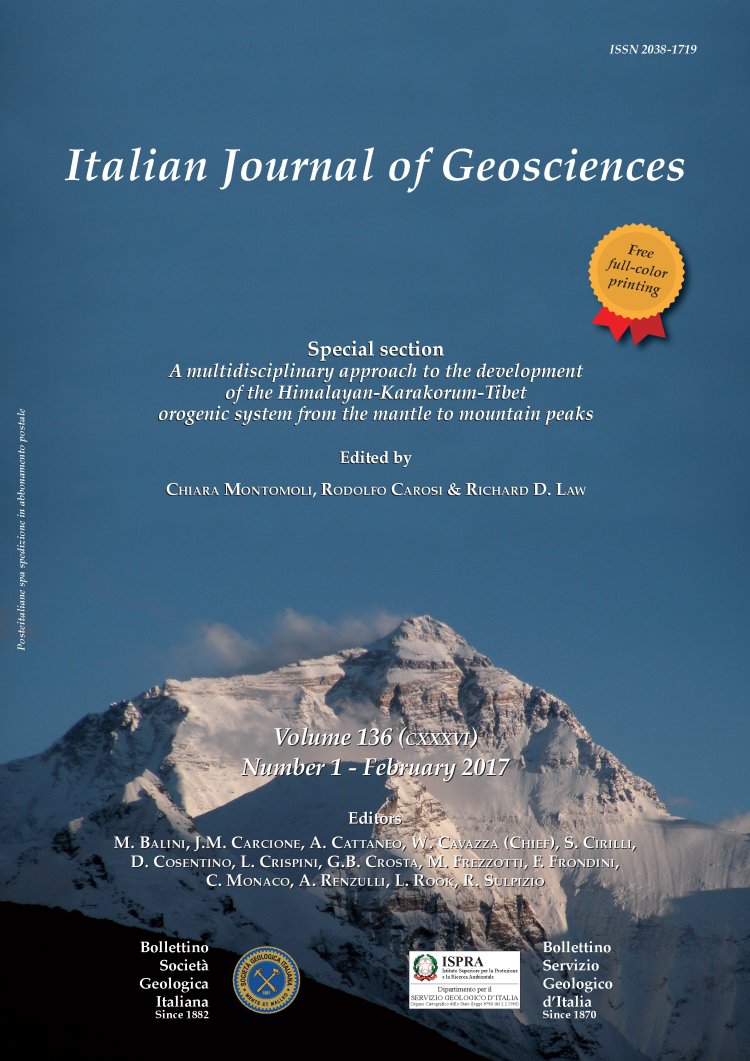
Tectonics of the Chamba Nappe, NW Himalaya and its regional implications
Surya Lahoti (*), Kislay Kumud (*), Yash Gupta (*) & Arvind Kumar Jain (**)
(*) Department of Earth Sciences, Indian Institute of Technology Roorkee, Roorkee-247667, India. Corresponding author e-mail: lahotisurya@gmail.com.
(**) CSIR-Central Building Research Institute, Roorkee-247667, India.
Volume: 136 (2017) f.1
Pages: 50-63
Abstract
In the western Himalaya the low-grade metamorphosed Tethyan Himalayan Sequence (THS) is thrust southwestward over the Higher Himalayan Crystallines (HHC) belt of the Chenab-Miyar valleys as the Chamba Nappe. This nappe cuts through the huge pile of the HHC metamorphics of Zanskar region due to top-to-the-SW-downward movement of the THS along the Chenab Shear Zone (CSZ). Since the main HHC belt is not exposed in the frontal parts, it is likely to be cut off by the CSZ and splay of the Main Central Thrust (MCT) in the basal parts. An intensely mylonitized 'Outer Granite Band'/Panjal mylonite beneath the low-grade THS metamorphics at the base of the Chamba Nappe, thus, represents the subthrust extension of the Kulu-Bajura Nappe of Himachal or the Munsiari Group mylonite of Garhwal, which are bounded by the Munsiari Thrust at the base and the Vaikrita Thrust at the top.
The Chamba Nappe is comprised of Proterozoic-Paleozoic-Mesozoic (THS) metasediments with southward verging Permo-Triassic Kalhel limestone that can be correlated with similar lithologies of the Tandi synform in the Chenab valley due to a huge D2 box fold structure, possibly developed over a ramp in the Main Himalayan Thrust (MHT). Progressive deformation of the Chamba Nappe since development of the first phase (D1) SW-vergent tectonics resulted in NE-plunging down-the-dip structural and mineral lineations (L1) on equally prominent foliation (S1) across all the lithotectonic units during ductile shearing and translation of the Chamba Nappe. Subsequent deformation phases - second deformation (D2) and third deformation (D3) - produced regional superposed folds and associated axial planar foliations, and appear to be part of the same deformation when the nappe was folded on large-scale due to resistance caused by the foreland in the south.
The Chamba Nappe is comprised of Proterozoic-Paleozoic-Mesozoic (THS) metasediments with southward verging Permo-Triassic Kalhel limestone that can be correlated with similar lithologies of the Tandi synform in the Chenab valley due to a huge D2 box fold structure, possibly developed over a ramp in the Main Himalayan Thrust (MHT). Progressive deformation of the Chamba Nappe since development of the first phase (D1) SW-vergent tectonics resulted in NE-plunging down-the-dip structural and mineral lineations (L1) on equally prominent foliation (S1) across all the lithotectonic units during ductile shearing and translation of the Chamba Nappe. Subsequent deformation phases - second deformation (D2) and third deformation (D3) - produced regional superposed folds and associated axial planar foliations, and appear to be part of the same deformation when the nappe was folded on large-scale due to resistance caused by the foreland in the south.
Keywords
Get Full Text